Steel Case
A steel case has been fabricated to house the Force Balance Vertical seismometer in order to better protect it from changes in atmospheric air pressure. The case is built using 1/2" cold-rolled steel and welded at both the inside corners and outside seams. The cover is also 1/2" thick steel. The seal at the bottom edge uses 3M Windo-Weld Ribbon 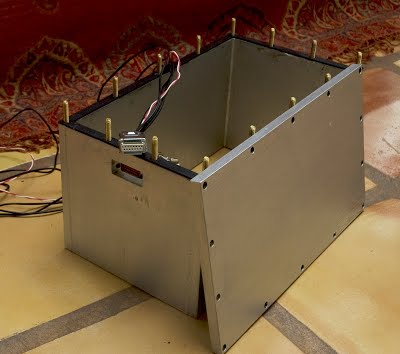 Sealer that is 3/8" diameter. This material is pliable and easy to form a good seal. The seal for the top cover uses 1/16" thick neoprene rubber sheet. One side of the rubber sheet has a self-sticky surface and is applied to the steel case.
Sealer that is 3/8" diameter. This material is pliable and easy to form a good seal. The seal for the top cover uses 1/16" thick neoprene rubber sheet. One side of the rubber sheet has a self-sticky surface and is applied to the steel case.
The feed-through is a hermetic 15-pin D-Sub connector. The hermetic seal consists of an O-ring imbedded in the connector. The connector 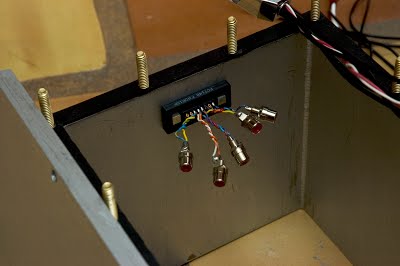 configuration is less than ideal but is the only one available without ordering 100 parts and a 12 week delivery. RCA phono connectors are used inside the case to connect to the seismometer.
configuration is less than ideal but is the only one available without ordering 100 parts and a 12 week delivery. RCA phono connectors are used inside the case to connect to the seismometer.
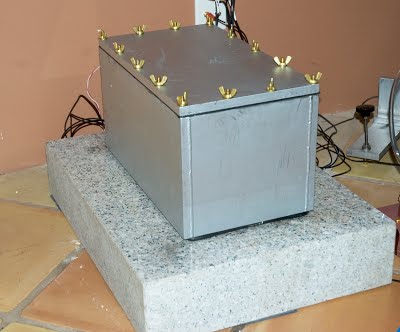
The Figure shows the steel case mounted on a granite slab with dimensions 15" x 20" x 4" thick. The slab is supported on the floor with 3 point suspension using small lead sheet cushions. The cover is held in place with brass 1/4-20NC wing-nuts. Previously the vertical seismometer was placed directly on the tile floor with a polycarbonate case enclosing it to shield against atmospheric pressure changes. It was shown this configuration was not very good in shielding against air pressure changes. Initially the seismometer was placed directly on the floor and steel case placed over it. Cover was put in place and seismometer was monitored for a day. What was seen was that the steel case did not do anything different! Maybe there was a leak. There was still strong correlation between atmospheric air pressure changes and the Inyo high gain output. The granite slab was waiting to be put in place, so that was next. The slab was leveled with lead sheet pieces and the case and seismometer installed. Now with the granite slab and steel case there is No correlation between air pressure changes and seismometer traces.
Testing the Steel Case
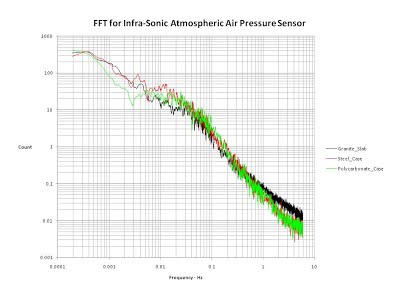
The figure shows Fast Fourier Transform traces from the air pressure sensor at 3 test times. The time between measurements was up to several days apart, but in all 3 cases, the weather was unsettled, rain, wind, etc.
The Figure displays FFT calculations for the seismometer with the previously used polycarbonate case, seismometer with steel case but mounted directly on floor and thirdly the seismometer with steel case and mounted on the granite slab. For each FFT  seismometer calculation there is the FFT air pressure calculation shown in figure above. The FFT calculations are 60 minute data traces. Now notice the much lower Granite_Slab trace in the 0.001 to 0.1Hz frequency range. The question is why didn't the steel case show better results when placed directly on the tile floor? The only answer I can supply is that the tile floor is not an acceptable surface to mount a vertical seismometer. There must be air leaks under the floor surface that one cannot see. The granite slab is the way to go. I see some 'pops' in the trace but no correlation with the air pressure sensor.
seismometer calculation there is the FFT air pressure calculation shown in figure above. The FFT calculations are 60 minute data traces. Now notice the much lower Granite_Slab trace in the 0.001 to 0.1Hz frequency range. The question is why didn't the steel case show better results when placed directly on the tile floor? The only answer I can supply is that the tile floor is not an acceptable surface to mount a vertical seismometer. There must be air leaks under the floor surface that one cannot see. The granite slab is the way to go. I see some 'pops' in the trace but no correlation with the air pressure sensor.




The top 2 small figures are typical Inyo seismometer and infra-sonic air pressure traces recorded during stormy weather. The Inyo seismometer was shielded from atmospheric pressure changes with the polycarbonate case, but no granite slab for a base. The bottom 2 figures were recorded during stormy weather as the top 2 small figures, but now the Inyo seismometer is shielded with the steel case and installed on a granite slab. Observe how much cleaner the traces are in the 3rd compared to first figure. If one looks closely to the top 2 small figures you will strong correlation. The traces on the top figure lag the air pressure changes by about 60 seconds. No correlation is observed when comparing bottom 2 figures.
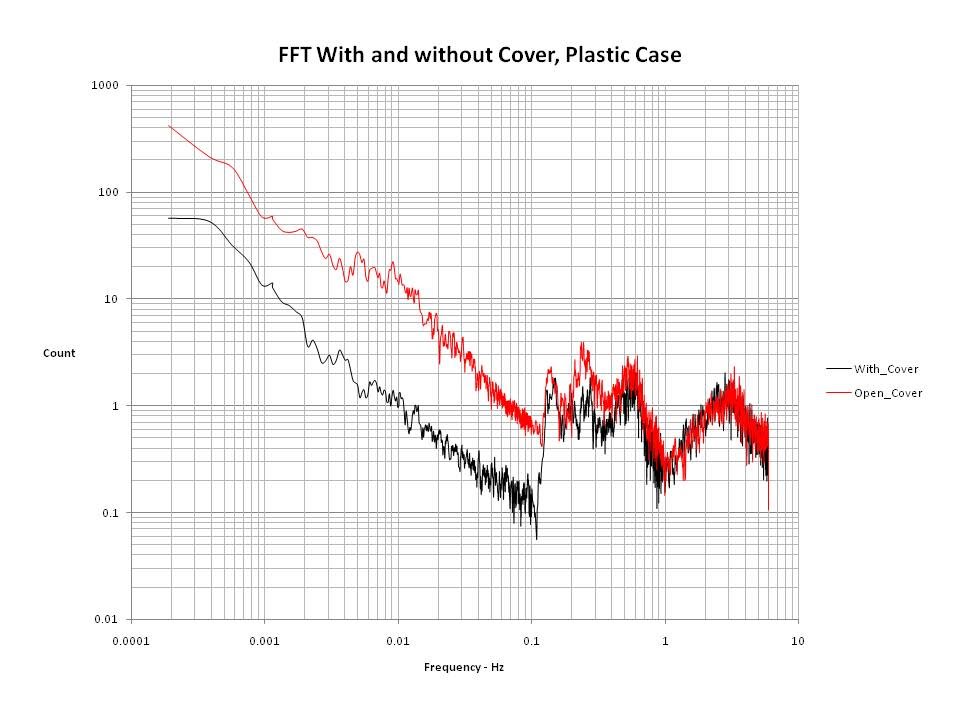 For polycarbonate it is 375,000 psi, however for steel it is 29,300,000 psi. This means that steel is 78 times stronger in resisting flexing. Using the
For polycarbonate it is 375,000 psi, however for steel it is 29,300,000 psi. This means that steel is 78 times stronger in resisting flexing. Using the 